The Friendly Fire Room Presents
Listen And See
Thank you Wanda Barlow for this great idea!
Pronouns Metaphors Errors Part 11
Pronouns Metaphors Errors Part 11
To God be the Glory, great things He has done.
mcmtffr.org wishes to acknowledge and thank Derek Konofalski and Rocket Media for making this page:
Mobile Friendly
Pronouns Metaphors, and Errors
Message
December 28, 2014
Part 11
Galatians 4:22-26
22 For it is written that Abraham had two sons: the one by a bondwoman, the other by a freewoman.
23 But he who was of the bondwoman was born according to the flesh, and he of the freewoman through promise,
24 which things are symbolic. For these are the two covenants: the one from Mount Sinai which gives birth to bondage, which is Hagar --
25 for this Hagar is Mount Sinai in Arabia, and corresponds to Jerusalem which now is, and is in bondage with her children --
26 but the Jerusalem above is free, which is the mother of us all.
FREE WOMAN is in this color
Bond woman is in this color
Common Text remains black.
22 For it is written that Abraham had two sons: the one by a bondwoman, the other by a freewoman.
23 But he who was of the bondwoman was born according to the flesh, and he of the freewoman through promise,
24 which things are symbolic. For these are the two covenants: the one from Mount Sinai which gives birth to bondage, which is Hagar --
25 for this Hagar is Mount Sinai in Arabia, and corresponds to Jerusalem which now is, and is in bondage with her children --
26 but the Jerusalem above is free, which is the mother of us all.
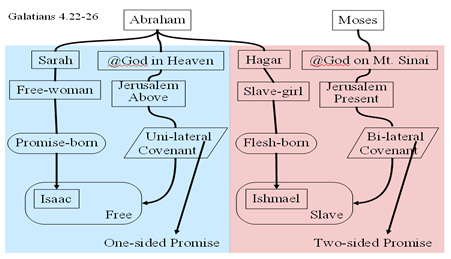
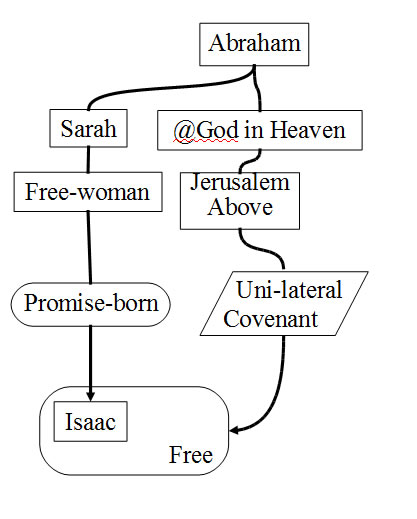
The theme of these representations has to do with God’s covenant promises, as in having been “conceived” at a place; namely, “in heaven”.
To the Hebrew mind-set, “in heaven” is an euphemistic term, and is effectively the same as saying conceived, or having its source “in God”.
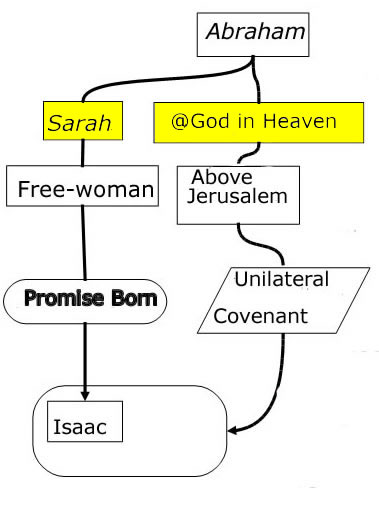
(Q) So, what does the
function or effects of the
metaphor Sarah have to
tell us about the
corresponding thing which
Sarah represents?
(A) The thing Sarah
represents is the place
where the promise was“conceived”, namely,
with God in Heaven.
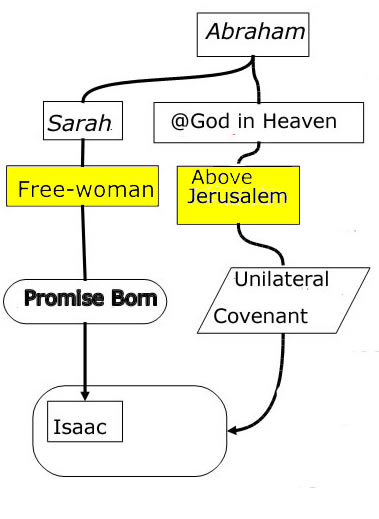
The next vertical element is Jerusalem Above, and is said to correspond to the metaphor
Free-woman, as in,
“the Jerusalem above is free”.
(Q) So, what does the
function or effects of the
metaphor Free-woman have to tell us about the
corresponding thing which
Free-woman represents?
(A) The thing Free-woman
represents is the kind or
quality of the sphere through which the promise
conceived becomes
particularized into
individual instances,
namely, through a Jerusalem
Above kind of conception, which
is totally apart from an indenture kind of conception, which binds one to a work.
26 but the Jerusalem above is free, which is the mother of us all.
Two important implications are:
(1) that which is conceived in Heaven and subsequently born out from the Jerusalem Above, is rightfully a full-citizen of heaven, and
(2) the Jerusalem Above is effectively the “mother” of all particular children who are born of the Promise of God, and therefore these children inherently retain freedom as an inseparable quality; they are the true Christians.
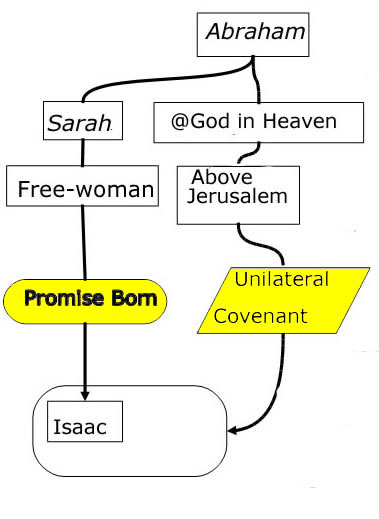
The next vertical element
is Uni-lateral Covenant,
and is the representation of the
metaphor Promise-born.
(Q) So, what does the
function or effects of the
metaphor Promise-born
have to tell us about the
corresponding thing
which Promise-born
represents?
(A) The thing Promise-born
represents is the kind or quality of covenant into which the promise
conceived is entered.
The kind of covenant is a Uni-lateral one; in which God takes the full responsibility of the promise to fulfill all the terms of the covenant.
The quality of this covenant
is super-natural in character;
where God’s ability guarantees
fulfillment rather than
having man’s lack of ability
assure its failure. The Promise of God is the
father of fulfillment, without the
promise of man being added to it.
Gen 2:16-17
Salvation has always been deliverance from the consequences of sin, leading to death.
Gen 6
Noah just did what God told him to do.
Noah did not add his own promise to God’s covenant by vowing to do it.
Gen 9
Noah was instructed not to eat the lifeblood or to take the lifeblood of man. It is God who establishes the covenant with Noah and his offspring after him.
Again, Noah does not add his own vow to the covenant.
Gen 15
God made a unilateral covenant with Abram.
Gen 17:9
In an unusual way, God promises to help Abram and his progeny keep the covenant by saying, “You shall keep my covenant, you and your offspring after you.”
Ex 24
At Sinai, after hearing all the words of the law, all the people answered as with one voice, “All the words that the Lord has spoken, we will do.”
Then, after the blood offering, Moses read out the written words of the covenant, and all said, “All that the Lord has spoken we will do, and we will be obedient.” Then Moses sealed it with the sprinkling of blood upon them.

The fulfillment of God’s Promise results in the bearing
of fruit; the offspring of the
promise, having a
corresponding kind of
quality as well.
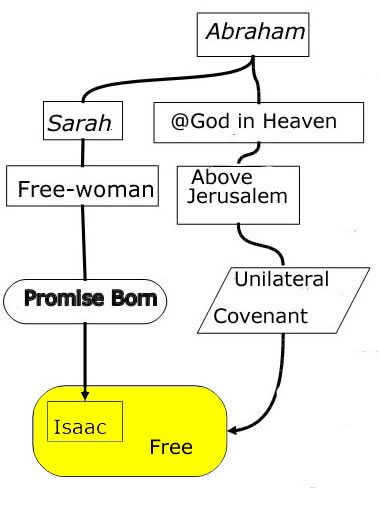
(Q) So, what does the function or effects of the
metaphor Isaac have to
tell us about the
corresponding thing
which Isaac represents?
(A) The thing Isaac represents is the kind of state or quality of sphere into which the fruit of the promise fully conceived is entered.
The covenant promise bears children, subsequently.
Such children which
correspond to Isaac, are
born of a unilateral
covenant which is free of
the limitations imposed by
man, so they supernaturally
born into a free status and into a heavenly sphere of existence.
When a child is born of a
free-woman, that child also
inherits the right to free
citizenship of the
city-state of its birth.
In this case the citizenship is
an extension of Heaven itself,
so that the heaven-born child’s
Father is God, his mother
(i.e. the one having given
birth) is Heaven itself,
represented here as Jerusalem
Above.
Notice that in all this, the idea of what Jerusalem is takes on a whole new meaning.
This allegory stresses the significance that the contrasting covenants are still producing their own kind of children today, which correspond in quality to either the supernatural promise or to the natural flesh.
We discover that a stark contrast has existed between the earthly Jerusalem and the Heavenly Jerusalem, from Jesus’ and Paul’s day, and continues unto our day.
That contrast takes us now to the second half of the allegory, to what Paul refers to as the second covenant.

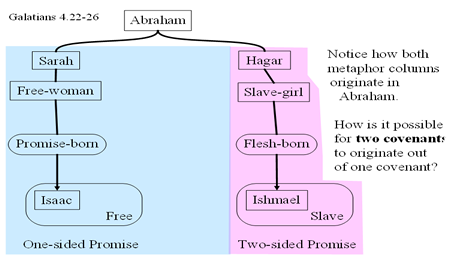
Because Abraham modified the first covenant by taking it on in the flesh. It is not so much that there are two separate covenants as that it is possible for a man to modify God’s covenant by adding his own promise (oath, vow) to do the original, as an expression of his own faith, thereby effectively creating a second covenant, a covenant of works based on man’s perception of his own ability to faithfully keep his vows to God.
Did God actually give man two covenants?
No. He simply does not stop man from placing himself into serious debt by writing checks that he cannot possibly make good on his own.
Those that trust in the Lord’s provision to fulfill the law are the true believers, and those that trust in their own flesh are not true believers.
When Abraham and Sarah first trusted in God to fulfill His promise to make them a multitude, they were true believers. But when they tried to fulfill God’s promise in their own flesh, they acted as unbelievers, and the kind of children they produced in the flesh became representative of the kind of people who trust in themselves and what they are capable of doing, and not trusting in God.
This became a two-sided promise because of man, not because of God.
The real essence of this is part of the allegory corresponds in every way to the pride of man.
He first inserts himself into the covenant at Sinai, then Jerusalem at the time of Christ had become the model of man’s effort to do the Law of God in his own strength.
He first inserts himself
into the covenant at Sinai,
then Jerusalem at the time
of Christ had become the
model of man’s effort to
do the Law of God and to
make his salvation
conditional upon his
ability to be obedient in
his own strength.
Only when God intervenes
into a person’s life and
quickens the heart
supernaturally in order to
deliver true conviction,
true convincing that only
the power of God’s provision
can truly save, will a person
escape the reality of being
in the state of Ishmael, in
slavery to the flesh.
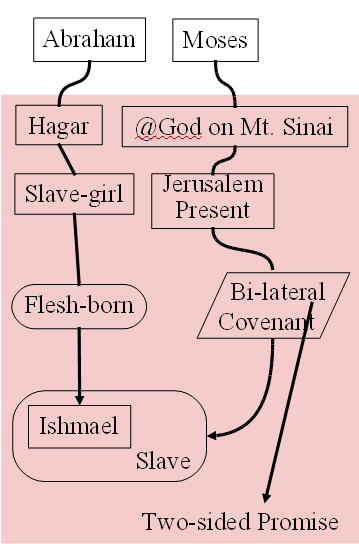

In Paul’s day, the problem in Galatia was that many in the churches were being convinced by false teachers to return to the slavery of Jerusalem and to the Old Covenant for salvation, and not acting as true believers.
Many Christians are confused by Paul’s teaching here, because they do not see how Jerusalem could be Hagar or how the Jews could be Ishmael. But Paul is not speaking genealogically, but allegorically.
The Jews, or anyone else, do not have to be physically descended from Hagar to be Ishmaelites.
Today, the problem day the problem in Galatia was that many in the churches were being convinced by false teachers to return to the slavery of Jerusalem and to the Old Covenant for salvation, and not acting as true believers.
Furthermore, Paul’s allegory shows Jerusalem is Hagar, and the heavenly Jerusalem is Sarah.
The children of those cities, corresponding to Ishmael and Isaac, are the adherents of Judaism and Christianity.
In other words, Jews considered the earthly Jerusalem to be their “mother,” while the Christians claimed the heavenly Jerusalem as their “mother.”
There is another thing that confuses many Christians about this allegory; and that is this question, “What is the New Covenant and what is the Old Covenant?”
Many Christians do not understand that the New Covenant was established even before the Old Covenant under Moses at Mt. Sinai.
Being a prior covenant, the New Covenant takes precedence over the Old Covenant.
That which we call the Old Covenant is basically Old Covenant religion, the the belief that salvation is based upon anyone's ability to keep his vow to the law of God or to follow Christ; therefore it has nothing to do with its age.
The Old Covenant is basically Old Covenant religion, the the belief that salvation is based upon anyone's ability to keep his vow to the law of God or to follow Christ.
That which we call the New Covenant is new with regard to the radical revelatory nature of it, being totally dependent upon God’s ability to keep His promise to save; neither does it have anything to do with its age.
The New Covenant is the belief that salvation is based upon the trust in God, that He is able to keep his promise to save. In Christ we see the means of actually accomplishing that promise.
While it is true that no one has ever been saved by the Old Covenant, all of the Old Testament saints were saved by the New Covenant; read about some of them in Hebrews 11.
Abraham, Moses, and Joshua were saved not by their own vows, but by God’s vow to them.
Many will be surprised on the Day of Judgment
when they discover
that it was just as the Word of God says;
only the righteousness of Christ is able to save you.All men are sinners and no one can save himself.
God is just, so He must punish sin;
but He is also merciful, moreover gracious,
and offers His Son as the perfect sacrifice
in order to purchase a place for you in heaven,
which He offers to you as the free gift of eternal life.Jesus is the Christ, the Messiah,
the Anointed One, He is God Incarnate.
In order to pay the debt of our sins,
He came from Heaven, having been sent by the Father,
where He lived a life of perfect obedience to the Father
even unto the shameful death upon the cross
in order to pay the debt of your sins.This gift must be received by faith,
believing that Jesus’ perfect life and Cross Work
was His complete and necessary Atonement
for your sins, in your behalf.
Faith is a gift that comes by the Power of God the Holy Spirit working in a person’s innermost being.
Only the power of God can open your heart to the willingness to have the void within it filled
with the presence of Christ by His Spirit.The Holy Spirit has the authority and power to quicken your dead spirit, to make it come to life.
Only the life of His Spirit’s quickening of your heart will allow the Gospel message of salvation to even make sense to you, to truly “hear” the message and give you the ability,
as the Holy Spirit bears witness to Jesus,
to recognize your need for forgiveness and restoration, and gain the desire of your heart to be favorably inclined to want to receive Christ as your personal Lord and Savior.If you have not done so before this moment,
ask Jesus to forgive you your sins,
tell Him you’ve stop trying to be your own savior,
and ask Him to come into your life right now,
and to give you eternal life. Then, in faith believing,
thank Him for the gift that He is giving you,
the one He paid for in full in your place,
in Jesus’ name,
AMEN
Copyright December, 2014
Rev. Jim Craig
All Rights Reserved
Bibliography
Agnes, Michael and Charlton Laird (eds.). Webster’s New World Dictionary and Thesaurus. New York, NY: Macmillan, 1996.
Aland, Kurt, Matthew Black, Carlo M. Martini, Bruce M. Metzger, and Allen Wikgren (eds.). The Greek New Testament, 4th rev. ed. Germany: Biblica-Druck, 1994.
Benner, Jeff A. The Ancient Hebrew Lexicon of the Bible. College Station, Texas: Virtualbookworm.com Publishing Inc., 2005
Bullinger, E. W. Figures of Speech Used in the Bible; Explained an Illustrated. Grand Rapids, Michigan: Baker Book House, 2007.
Chapman, Benjamin. Greek New Testament Insert. Grand Rapids, Michigan: Baker Book House, 1977.
Dana, H. E., and Julius R. Mantey. A Manual of the New Testament. Canada: The Macmillan Company, 1957.
Louw, Johannes P. and Eugene A. Nida. Greek-English Lexicon of the New Testament Based on Semantic Domains. New York, NY: United Bible Societies, 1989.
The ESV Study Bible. Wheaton, Illinois: Crossway, 2011.
Metzger, Bruce M. Lexical Aids for Students of New Testament Greek. Princeton, New Jersey, 1977.
Wikipedia contributors. "Xenophon." Wikipedia, The Free Encyclopedia. Wikipedia, The Free Encyclopedia, 15 Aug. 2014. Web. 19 Aug. 2014.
Wuest, Kenneth S. The New Testament; An Expanded Translation. Grand Rapids, Michigan, 1992.
Wuest, Kenneth S. (Revised, Donald L. Wise). The Practical Use of the Greek New Testament, rev. ed. Chicago, Il: Moody Press, 1982.
Walsh, J. Martyn and Anna Kathleen Walsh. Plain English Handbook: A Complete Guide to Good English, 7th rev. ed. Cincinnati, Ohio: McCormick-Mathers PublishingCompany,1977.